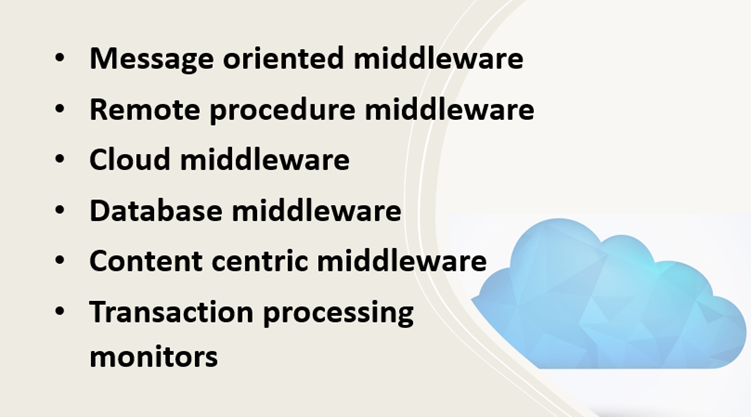“Hello my fellow technology enthusiasts, I wanted to speak about a subject that is recognized in its true nature by all but seldom understood. The topic is “Cloud Computing” and will be addressed in series. So, let ‘s dive into the world of cloud computing. In this blog I am going to focus on cloud storage which include:
What is middleware?
How middleware works?
Types of middleware
Why middleware is important to cloud computing?
What is middleware?

Middleware is software that provides programmes with common features and functionality independent of what the operating system offers. All middleware is generally managed by data processing, application services, messaging, authentication, and API management. Using middleware helps users to make requests, such as sending forms to a web browser or enabling a web server to return dynamic web pages depending on a user’s profile.
Database middleware, application server middleware, message-oriented middleware, network middleware and transaction-processing controls are typical examples of middleware. Using communicating mechanisms such as simple object access protocol (SOAP), web servers, representational state transfer (REST) and JavaScript object notation (JSON), each programme usually offers messaging services so that different programmes can interact.
Click here to purchase any IT related software or hardware
How middleware works?
The value of middleware has been enhanced by the enhanced use of network apps by corporations and tech start-ups. SAAS organisations and start-ups alike build enterprise-wide information networks by combining previously self-sustaining applications with new product upgrades using middleware.
Information-based systems are composed of a set of separate hardware devices linked by a network to each other. Each computer executes tasks that include the transmission of real-time data, with participation from other devices. Such encounters extend over a vast spectrum of performances. Thus, middleware is successfully used to connect multiple applications.
Click here for general IT Support services for Businesses
Types of middleware

Message oriented middleware
Message Oriented Middleware (MOM) is an infrastructure for software / hardware that supports receiving and transmitting messages via distributed apps. It is less difficult to distribute applications across multiple devices and to build desktop applications composed of several operating systems and network protocols. It is one of the types of middleware that is most used.
Remote procedure middleware
RPCs are synchronous they are called blocking middleware and before the effects of the remote process are returned, the requesting programme is suspended. As the RPC uses point-to – point communication, during their processing they are not flexible and require a large amount of resources. Despite the simplicity, the difficulty of their maintenance and efficiency problems, in circumstances where many systems need convergence, this middleware is not a feasible solution.
Cloud middleware
A vast number of computers connected by a high-speed network are also enclosed by datacentres operating a cloud environment. Via the public Internet, consumers enter sites hosted by the cloud environment. Usually, a site is accessed from a URL that is
Translated via a global directory utility, such as DNS, to a network address. A submission to a site is forwarded to a computer inside the datacentre through the Internet that either processes or forwards the submission.
Database middleware
Database middleware facilitates connectivity from an application or from applications to a database. It is used to retrieve information from records that are either local or remote. It operates with two types of databases, CLIs (Call Level Interfaces) and Middleware at-native database. CLIs offer, via a standard GUI, access to any range of relational databases. Native database middleware, on the other hand, uses only specific methods to use the functionality and functions of a given data base.
Content centric middleware
Without wondering how it is obtained, this sort of middleware helps you to abstract content. This is done through a simple abstraction of providing / consuming. It is comparable to middleware publishing / subscribing, which is another form of programme that is sometimes used as part of software that are web-based.
Transaction processing monitors
They are a type of middleware that maintains a transaction ‘s integrity. To remove single points of failure, TP Monitors support functionality such as rollback, failover, auto restart, error recording and replication. In addition to coordination between two or more applications, they have a place for application logic.
Click here for cloud based solutions for the businesses like Google, AWS and Azure
Why middleware is important to cloud computing?
Applications, from on-site applications to public databases, may be implemented across various infrastructures. Architectures may be broadly different. Many instruments, languages, and systems are being juggled by developers. And in less time and at a smaller cost, the heat is on to do better.
To handle this complexity and to keep programme creation fast and cost-effective, companies shift to middleware. Middleware should support application environments that operate through a dynamically distributed network seamlessly and reliably.
